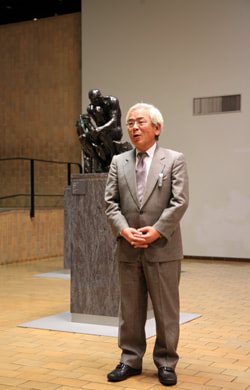
Masanori Aoyagi, the director of the National Museum of Western Art
Masanori Aoyagi, the director of the National Museum of Western Art, guided us around the museum.
Q : The collection of the museum is based on the Matsukata Collection that was gathered by Kojiro Matsukata. Could you tell us how the museum acquired the Matsukata Collection?
Japan had adopted the ample assets of Western Art, and new art and cultures were formed.
Aoyagi: The items of the Matsukata Collection were collected in England, France, Italy and Germany around 1926 by Kojiro Matsukata, a businessman who succeeded in the shipbuilding industry. He used his own money to buy those artworks for young people.
He was the third son of Masayoshi Matsukata, an expert on financial affairs and founder of the Bank of Japan. He studied in the United States at a young age, and graduated from Yale University with Master's degree. With the cooperation of Frank Brangwyn, a painter, he began collecting artworks during his stay in London, expending more than 30 million yen worth of his own funds to buy them. It is now worth more than 1 trillion yen. It was almost the same as the building cost of the battleship Mutsu, which was equivalent to more than 2% of the 600 million yen national budget at that time. (continued in the lower column)
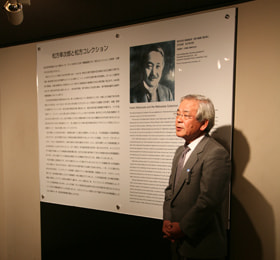
However, Kojiro Matsukata became bankrupt due to the Great Depression, his collection was dispersed, and artworks stored in London were destroyed by fire. Only about 400 items of the collection stored in France were remained. After the Japanese government, through then Prime Minister Shigeru Yoshida, requested the return of the collection stored in France, the collection's return was approved in 1957. At that time, since the artworks were sequestered and became the French government property under the San Francisco Peace Treaty, the two governments had different perceptions; the Japanese government recognized the handover as "return" and the French government considered it as "donation," so it was referred to as "Henkan-kizo," or return/donation. 371 items were returned, but especially valuable 20 or so items were not returned. (continued in the right column)
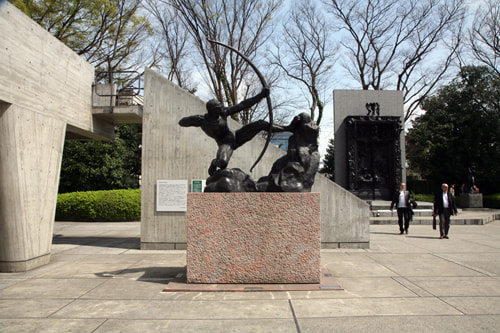
Émile-Antoine Bourdelle, "Hercules the Archer" (1909, Main Building's front garden)
Sculptures by Rodin and Bourdelle who was an assistant of Rodin are placed in the Main Building's front garden

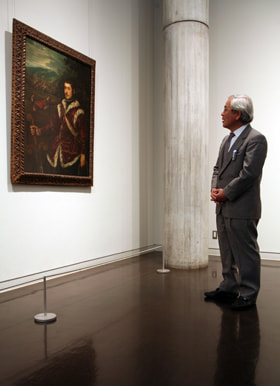
Seeing "Portrait of a Young Man as David" (c. 1555-60) by Tintoretto (Jacopo Robusti)

Kojiro was born in 1866 in Satsuma Province (present-day Kagoshima Prefecture) as the third son of Masayoshi Matsukata who served as Finance Minister, established the Bank of Japan, and later became Prime Minister in the Meiji Period. He studied at Yale University after studying at Tokyo Imperial University, and, after returning home, was appointed as the first president of Kawasaki Dockyard Co., Ltd. at the request of Shozo Kawasaki who was the founder of the Kawasaki conglomerate. He also held various posts, and later served as a House of Representatives member.
A: Could you tell us about the history of the Main Building designed by Le Corbusier?
The efforts of Kunio Maekawa, Junzo Sakakura and Takamasa Yoshizaka, who became apprenticed to Le Corbusier, bore fruit.
The Main Building of the National Museum of Western Art was designed by Le Corbusier who actively worked at that time. Although, at first, Le Corbusier was reluctant to design the museum, it was realized through the efforts of his disciples, Kunio Maekawa, Junzo Sakakura and Takamasa Yoshizaka. Since the economy was very bad around 1959, only about 50 million yen, which was approximately half of the cost to build the museum, was funded by the government. Therefore, businessmen, statesmen and cultural figures, including Aiichiro Fujiyama and Ryuzaburo Umehara, started to raise more than 100 million yen, and then the construction of the museum could begin without any complications. It was completed in 1961.
Now, the Fondation Le Corbusier in Paris has been campaigning to collectively register his works around the world as World Heritage sites for about four years. In Japan, in order for a building to be registered as a World Heritage, it should be designated as an Important Cultural Property in the first place. Generally, a modern building is not granted World Heritage status if 50 years have not passed since its completion. In 2009, 50 years have passed since this museum was constructed. Although the Fondation Le Corbusier collectively applied for World Heritage status for other Le Corbusier's works and the Japanese Agency for Cultural Affairs designated this museum as an Important Cultural Property when 49 years had passed since its completion in 2008, the World Heritage Committee referred the nomination back to the applicant (the French Government) for additional information and the museum was not inscribed on the World Heritage List. The Fondation Le Corbusier is planning to further investigate Le Corbusier's works located at 23 places in seven countries, and will apply for it again next year.(continued in the next page)
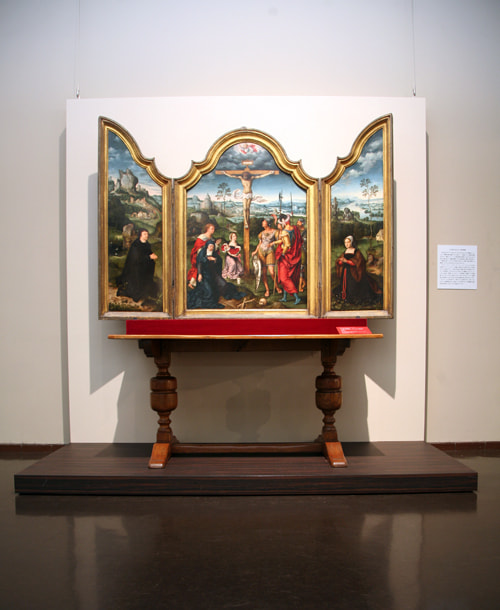
Joachim Patinir and Joos van Cleve worked in Antwerp in the first half of the 16th century. Patinir school painters depicted the life of Jesus Christ in magnificent landscapes. In the triptych by Cleve, the Crucifixion is painted on the center panel and the kneeling donor of the triptych and his wife are painted on the side panels against the background of a continuous stretch of land.


Masanori Aoyagi, the director of the National Museum of Western Art










